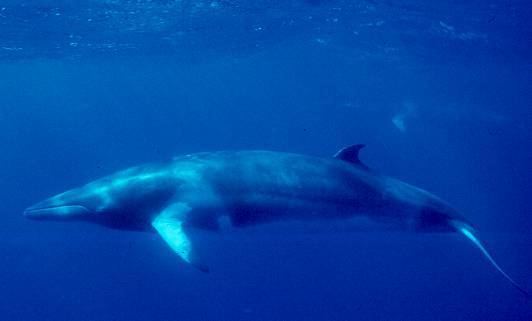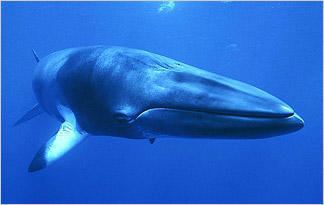Phylum Chordata Subclass Eutheria Suborder Mysticeti | ||
 | ||
Representative species Common minke whale, Antarctic minke whale, Dwarf minke whale, Scammon's minke whale | ||
Minke whale
Minke whale /ˈmɪnki/, or lesser rorqual, is a name given to two species of marine mammal belonging to a clade within the suborder of baleen whales. The minke whale was given its official designation by Lacepède in 1804, who described a juvenile specimen of Balænoptera acuto-rostrata. The name is a partial translation of Norwegian minkehval, possibly after a Norwegian whaler named Meincke, who mistook a northern minke whale for a blue whale.
Contents
- Minke whale
- Swimming with dwarf minke whales on board eye to eye marine encounters sunday night program
- Taxonomy
- Description
- Behavior
- Reproduction
- Population and conservation status
- Whaling
- Whale watching
- References

Swimming with dwarf minke whales on board eye to eye marine encounters sunday night program
Taxonomy
Most modern classifications split the minke whale into two species;

Taxonomists further categorize the common minke whale into two or three subspecies; the North Atlantic minke whale, the North Pacific minke whale and dwarf minke whale. All minke whales are part of the rorquals, a family that includes the humpback whale, the fin whale, the Bryde's whale, the sei whale and the blue whale.

The junior synonyms for B. acutorostrata are B. davidsoni (Scammon 1872), B. minimia (Rapp, 1837) and B. rostrata (Fabricius, 1780). There is one synonym for B. bonaerensis - B. huttoni (Gray 1874).

Writing in his 1998 classification, Rice recognized two of the subspecies of the common minke whale - B. a. scammoni (Scammon's minke whale) and a further (taxonomically) unnamed subspecies found in the Southern Hemisphere, the dwarf minke whale (first described by Best, 1985).
On at least one occasion, an Antarctic minke whale has been confirmed migrating to the Arctic. In addition, at least two wild hybrids between a common minke whale and an Antarctic minke whale have been confirmed.
Description

The minke whales are the second smallest baleen whale; only the pygmy right whale is smaller. Upon reaching sexual maturity (6–8 years of age), males measure an average of 6.9 m (23 ft) and females 8 m (26 ft) in length, respectively. Reported maximum lengths vary from 9.1 to 10.7 m (30 to 35 ft) for females and 8.8 to 9.8 m (29 to 32 ft) for males. Both sexes typically weigh 4–5 t (3.9–4.9 long tons; 4.4–5.5 short tons) at sexual maturity, and the maximum weight may be as much as 10 t (9.8 long tons; 11 short tons).
The minke whale is a black/gray/purple color. Common minke whales (Northern Hemisphere variety) are distinguished from other whales by a white band on each flipper. The body is usually black or dark-gray above and white underneath. Minke whales have between 240 and 360 baleen plates on each side of their mouths. Most of the length of the back, including dorsal fin and blowholes, appears at once when the whale surfaces to breathe.
Minke whales typically live for 30–50 years; in some cases they may live for up to 60 years.
The brains of minke whales have around 12.8 billion neocortical neurons and 98.2 billion neocortical glia.
Behavior
The whale breathes three to five times at short intervals before 'deep-diving' for two to 20 minutes. Deep dives are preceded by a pronounced arching of the back. The maximum swimming speed of minkes has been estimated at 38 km/h (24 mph).
Reproduction
The gestation period for minke whales is 10 months, and calves measure 2.4 to 2.8 m (7.9 to 9.2 ft) at birth. The newborns nurse for five to 10 months. Breeding peaks during the summer months. Calving is thought to occur every two years.
Population and conservation status
The IUCN Red List labels the common minke whale as Least Concern. The Antarctic minke whale is listed as Data Deficient.
COSEWIC puts both species in the Not At Risk category [1]. NatureServe lists them as G5 which means the species is secure on global range [2].
In 2012, the Scientific Committee of the International Whaling Commission agreed upon a population estimate of 515,000 for the Antarctic minke stock. The Scientific Committee acknowledged that this estimate is subject to a negative bias because some minke whales would have been outside the surveyable ice edge boundaries.
Whaling
Whaling was mentioned in Norwegian written sources as early as the year 800, and hunting minke whales with harpoons was common in the 11th century. In the 19th century, they were considered too small to chase, and received their name from a young Norwegian whale-spotter in the crew of Svend Foyn, who harpooned one, mistaking it for a blue whale and was derided for it.
By the end of the 1930s, they were the target of coastal whaling by Brazil, Canada, China, Greenland, Japan, Korea, Norway, and South Africa. Minke whales were not then regularly hunted by the large-scale whaling operations in the Southern Ocean because of their relatively small size. However, by the early 1970s, following the overhunting of larger whales such as the sei, fin, and blue whales, minkes became a more attractive target of whalers. By 1979, the minke was the only whale caught by Southern Ocean fleets. Hunting continued apace until the general moratorium on whaling began in 1986.
Following the moratorium, most hunting of minke whales ceased. Japan continued catching whales under the special research permit clause in the IWC convention, though in significantly smaller numbers. The stated purpose of the research is to establish data to support a case for the resumption of sustainable commercial whaling. Environmental organizations and several governments contend that research whaling is simply a cover for commercial whaling. The 2006 catch by Japanese whalers included 505 Antarctic minke whales.
Although Norway initially followed the moratorium, they had placed an objection to it with the IWC and resumed a commercial hunt of the Common minke whale in 1993. The quota for 2006 was set at 1,052 animals, but only 546 were taken. The quota for 2011 is set at 1286. In August 2003, Iceland announced it would start research catches to estimate whether the stocks around the island could sustain hunting. Three years later, in 2006, Iceland resumed commercial whaling.
A 2007 analysis of DNA fingerprinting of whale meat estimated South Korean fishermen caught 827 minke between 1999 and 2003, approximately twice the officially reported number. This raised concerns that some whales were being caught deliberately.
Whale watching
Due to their relative abundance, minke whales are often the focus of whale-watching cruises setting sail from, for instance, the Isle of Mull in Scotland, County Cork in Ireland and Húsavík in Iceland, and tours taken on the east coast of Canada. They are also one of the most commonly sighted whales seen on whale-watches from New England and eastern Canada. In contrast to humpback whales, minkes do not raise their flukes out of the water when diving and are less likely to breach (jump clear of the sea surface). This, combined with the fact that minkes can stay submerged for as long as 20 minutes, has led some whale-watchers to label them 'stinky minkes'.
In the northern Great Barrier Reef (Australia), a swim-with-whales tourism industry has developed based on the June/July migration of dwarf minke whales. A limited number of reef tourism operators (based in Port Douglas and Cairns) have been granted permits by the Great Barrier Reef Marine Park Authority to conduct these swims, given strict adherence to a code of practice, and that operators report details of all sightings as part of a monitoring program.
Scientists from James Cook University and the Museum of Tropical Queensland have worked closely with participating operators and the Authority, researching tourism impacts and implementing management protocols to ensure these interactions are ecologically sustainable.
Minke whales are also occasionally sighted in Pacific waters, in and around the Haro Strait of British Columbia and Washington State.
